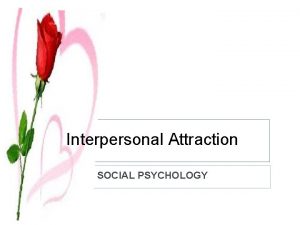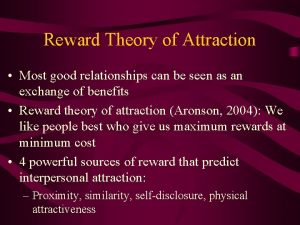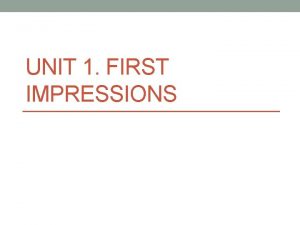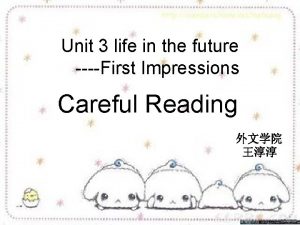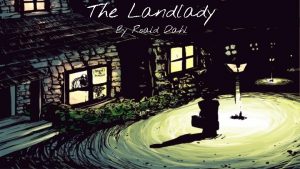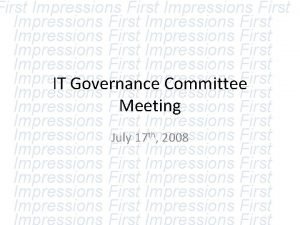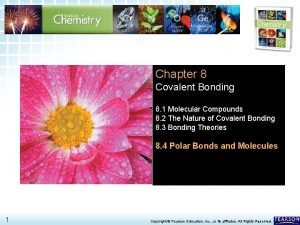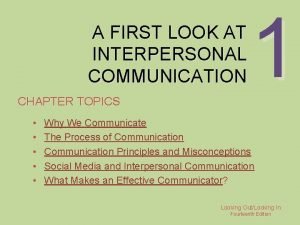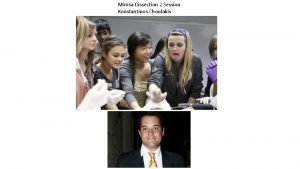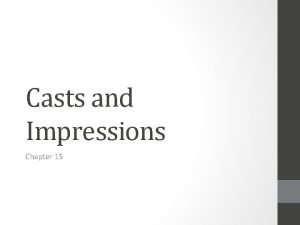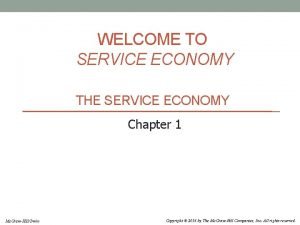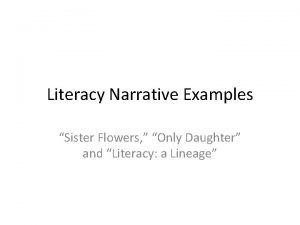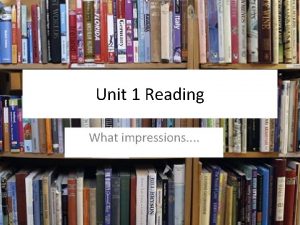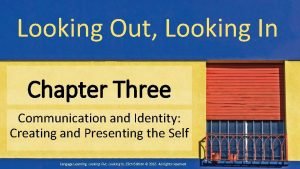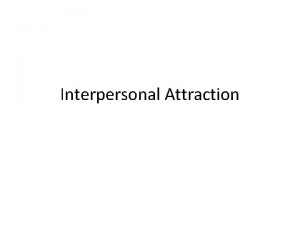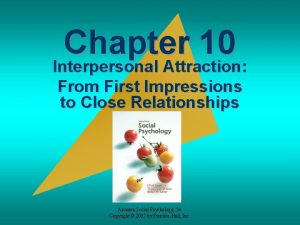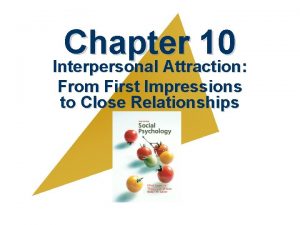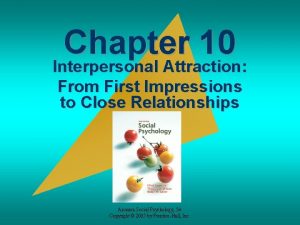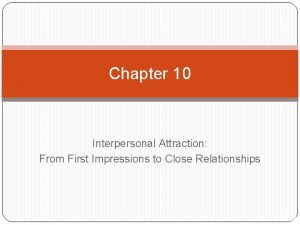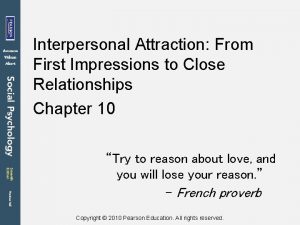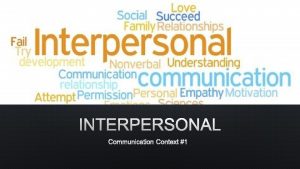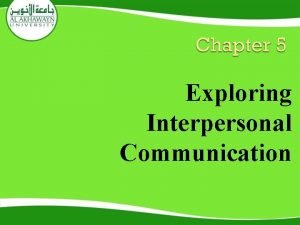Chapter 10 Interpersonal Attraction From First Impressions to



















































- Slides: 51

Chapter 10 Interpersonal Attraction: From First Impressions to Close Relationships Copyright © 2016, 2013, 2010 Pearson Education, Inc. All Rights Reserved

The Person Next Door: The Propinquity Effect O The finding that the more we see and interact with people, the more likely they are to become our friends Copyright © 2016, 2013, 2010 Pearson Education, Inc. All Rights Reserved

The Person Next Door: The Propinquity Effect O Functional distance = certain aspects of architectural design that make it more likely that some people will come into contact with each other more often than with others Copyright © 2016, 2013, 2010 Pearson Education, Inc. All Rights Reserved

The Person Next Door: The Propinquity Effect Mere Exposure Effect = more exposure we have to a stimulus, the more apt we are to like it Copyright © 2016, 2013, 2010 Pearson Education, Inc. All Rights Reserved

Figure Your social life likely has more to do with floor plans than you think! The physical layout of a building can play a surprising role in relationship formation. Research indicates that in a residential building like the one pictured here, the closer two people’s apartments are, the more likely they are to become friends. And those residents who live near the stairs or elevator are more likely to make friends with people who live on other floors of the building. Source: Shutterstock Copyright © 2016, 2013, 2010 Pearson Education, Inc. All Rights Reserved

Similarity O “Birds of a feather flock together” (similarity) O What about “opposites attract” (complementarity)? O Research overwhelmingly supports O Similarity O Not complementarity Copyright © 2016, 2013, 2010 Pearson Education, Inc. All Rights Reserved

Opinions and Personality O Greater similarity leads to more liking O Newcomb (1961): College men became friends with those who were similar in O Demographics O Attitudes O Values Copyright © 2016, 2013, 2010 Pearson Education, Inc. All Rights Reserved

Interests and Experiences O Situations you choose to be in expose you to others with similar interests. O Then, when you discover and create new similarities, they fuel the friendship. O Close friendships are often made in college, in part because of prolonged propinquity. Copyright © 2016, 2013, 2010 Pearson Education, Inc. All Rights Reserved

Similarity in Appearance O Seek physical proximity to those similar in appearance O Seek others with similar degree of physical attractiveness Copyright © 2016, 2013, 2010 Pearson Education, Inc. All Rights Reserved

Similarity in Committed Relationships Versus “Flings” O For committed relationship O Choose a similar partner O Relationships based on differences can be difficult to maintain O Perceived similarity more important than actual similarity O Low level of commitment (fling) O Choose dissimilar partners Copyright © 2016, 2013, 2010 Pearson Education, Inc. All Rights Reserved

Reciprocal Liking O We like people who like us O For initial attraction, reciprocal liking can overcome O Dissimilarity in attitudes O Attentional biases to attractive faces Copyright © 2016, 2013, 2010 Pearson Education, Inc. All Rights Reserved

Always Looking One indicator of just how important physical appearance is in attraction is our nearly chronic tendency to shift visual attention to attractive others in our immediate vicinity. Source: Radius Images/Getty Images Copyright © 2016, 2013, 2010 Pearson Education, Inc. All Rights Reserved

Playing hard to get… O The finding that we like people who like us suggests that the strategy of “playing hard -to-get” can sometimes backfire. O strategy tends to decrease how much another person likes you, all the while potentially increasing how much that person wants to be with you. Copyright © 2016, 2013, 2010 Pearson Education, Inc. All Rights Reserved

Female Faces—What Is Attractive? O High attractiveness ratings are associated with: O Large eyes O Small nose O Small chin O Prominent cheekbones O High eyebrows O Large pupils O Big smile Copyright © 2016, 2013, 2010 Pearson Education, Inc. All Rights Reserved

Male Faces—What Is Attractive? O High attractiveness ratings are associated with: O Large eyes O Prominent cheekbones O Large chin O Big smile Copyright © 2016, 2013, 2010 Pearson Education, Inc. All Rights Reserved

Cultural Standards of Beauty O Facial attractiveness perceived similarly across cultures O Symmetry is preferred O Size, shape, and location of the features on one side match the other side of face O “Averaged” composite faces preferred Copyright © 2016, 2013, 2010 Pearson Education, Inc. All Rights Reserved

Averaging for Beauty Physical attractiveness of composite faces. Langlois and Roggman (1990) created composites of faces using a computer. Pictured here is the first step in the process: The first two women’s photos are merged to create the “composite person” at the far right. This composite person has facial features that are the mathematical average of the facial features of the two original women. Source: Dr. Judith Langlois Copyright © 2016, 2013, 2010 Pearson Education, Inc. All Rights Reserved

The Power of Familiarity O Familiarity may be crucial variable for interpersonal attraction. O People prefer faces that most resemble their own. Copyright © 2016, 2013, 2010 Pearson Education, Inc. All Rights Reserved

Assumptions About Attractive People (2 of 3) O Physical beauty affects attributions O Halo Effect: O A cognitive bias by which we tend to assume that an individual with one positive characteristic also possesses other (even unrelated) positive characteristics Copyright © 2016, 2013, 2010 Pearson Education, Inc. All Rights Reserved

Assumptions About Attractive People (3 of 3) O “What is beautiful is good” stereotype O The beautiful are thought to be more: O Sociable O Extraverted O Popular O Sexual O Happy O Assertive Copyright © 2016, 2013, 2010 Pearson Education, Inc. All Rights Reserved

All Princesses Are Beautiful in Children’s Movies It’s no coincidence that in children’s movies, the hero is traditionally attractive and the villain ugly. In addition to finding it pleasing to look at attractive others, we also tend to assume that “what is beautiful is good. ” Source: WALT DISNEY PICTURES/Album/Newscom Copyright © 2016, 2013, 2010 Pearson Education, Inc. All Rights Reserved

Table 10. 1 Culture and the “What Is Beautiful Is Good” Stereotype Traits Shared in the Korean, American, and Canadian Stereotype sociable extraverted likable happy popular well-adjusted friendly mature poised sexually warm/responsive Additional Traits Present in the American and Canadian Stereotypes strong assertive dominant Additional Traits Present in the Korean Stereotypes sensitive empathic honest trustworthy generous The “what is beautiful is good” stereotype has been explored in both individualistic cultures (e. g. , North America) and collectivistic cultures (e. g. , Asia). Male and female participants in the United States, Canada, and South Korea rated photographs of people with varying degrees of physical attractiveness. Responses indicated that some of the traits that make up the stereotype are the same across cultures, while other traits associated with the stereotype are different in the two cultures. In both cultures, the physically attractive are seen as having more of the characteristics that are valued in that culture than do the less physically attractive. (Based on Eagly, Ashmore, Makhhijani, & Longo, 1991; Feingold, 1992 b; Wheeler & Kim, 1997) Copyright © 2016, 2013, 2010 Pearson Education, Inc. All Rights Reserved

Evolution and Mate Selection O Evidence for evolutionary approach: O Asked more than 9, 000 adults in 37 countries desirable marriage partner characteristics (Buss, 1989; Buss et al. , 1990) O Women: valued ambition, industriousness, and earning capacity more than men O Men: valued attractiveness more than women O Top characteristics for both the same: O honesty, trustworthiness, pleasant personality Copyright © 2016, 2013, 2010 Pearson Education, Inc. All Rights Reserved

Love and Close Relationships 10. 3 What is love and what gives people satisfaction in close relationships? Copyright © 2016, 2013, 2010 Pearson Education, Inc. All Rights Reserved

Defining Love (1 of 2) O Companionate Love O The intimacy and affection we feel when we care deeply for a person, whose life we are intertwined with. O Do not experience passion or arousal in the person’s presence. Copyright © 2016, 2013, 2010 Pearson Education, Inc. All Rights Reserved

Companionate Love O Nonsexual relationships O Close friendships O Sexual relationships O Psychological intimacy without “heat” and passion Copyright © 2016, 2013, 2010 Pearson Education, Inc. All Rights Reserved

Defining Love (2 of 2) O Passionate Love O An intense longing we feel for a person, accompanied by physiological arousal O When our love is reciprocated, we feel great fulfillment and ecstasy O When it is not, we feel sadness and despair Copyright © 2016, 2013, 2010 Pearson Education, Inc. All Rights Reserved

Passionate Love O Intense longing for another person, characterized by: O The experience of physiological arousal O The feeling of shortness of breath O Thumping heart in loved one’s presence Copyright © 2016, 2013, 2010 Pearson Education, Inc. All Rights Reserved

Table 10. 2 Cross-Cultural Evidence for Passionate Love Based on Anthropological Research in 166 Societies Cultural Area Passionate Love Present Passionate Love Absent Mediterranean 22 (95. 7%) 1 (4. 3%) Sub-Saharan Africa 20 (86. 9%) 6 (23. 1%) Eurasia 32 (97. 0%) 1 (3. 0%) Insular Pacific 27 (93. 1%) 2 (6. 9%) North America 24 (82. 8%) 5 (17. 2%) South and Central America 22 (84. 6%) 4 (15. 4%) (Based on data from Jankowiak & Fischer, 1992) Copyright © 2016, 2013, 2010 Pearson Education, Inc. All Rights Reserved

Passionate and Companionate Love Across Cultures O Americans value passionate love more than the Chinese O The Chinese value companionate more O Taita of Kenya value both equally Copyright © 2016, 2013, 2010 Pearson Education, Inc. All Rights Reserved

Culture and Love O Japanese amae O Totally passive love object, indulged and taken care of by one’s romantic partner O Chinese gan qing O Achieved by helping and working for another person O Korean jung O Connection that ties people together Copyright © 2016, 2013, 2010 Pearson Education, Inc. All Rights Reserved

Weddings Across Cultures Although people all over the world experience love, how love is defined varies across cultures. Source: (left) image. BROKER/Alamy; (right): vario images Gmb. H & Co. KG/Alamy Copyright © 2016, 2013, 2010 Pearson Education, Inc. All Rights Reserved

Attachment Styles in Intimate Relationships O Attachment Styles O The expectations people develop about relationships with others, based on the relationship they had with their primary caregiver when they were infants O There are three styles of attachment: O Secure O Anxious/Ambivalent O Avoidant Copyright © 2016, 2013, 2010 Pearson Education, Inc. All Rights Reserved

Table 10. 3 Measuring Adult Attachment Style Secure style 56% “I find it relatively easy to get close to others and am comfortable depending on them and having them depend on me. I don’t often worry about being abandoned or about someone getting too close. ” Avoidant style 25% “I am somewhat uncomfortable being close to others; I find it difficult to trust them completely, difficult to allow myself to depend on them. I am nervous when anyone gets close, and often love partners want me to be more intimate than I feel comfortable being. ” Anxious style 19% “I find that others are reluctant to get as close as I would like. I often worry that my partner doesn’t really love me or won’t stay with me. I want to merge completely with another person, and this desire sometimes scares people away. ” As part of a survey of attitudes toward love published in a newspaper, people were asked to choose the statement that best described their romantic relationships. The attachment style each statement was designed to measure and the percentage of people who chose each alternative are indicated. (Adapted from Hazan & Shaver, 1987) Copyright © 2016, 2013, 2010 Pearson Education, Inc. All Rights Reserved

Attachment Style Is Not Destiny O If people had unhappy relationships with their parents, they are not doomed to repeat this! O People’s experience in relationships can help them learn new and more healthy ways of relating to others. O People may develop more than one attachment style over time. Copyright © 2016, 2013, 2010 Pearson Education, Inc. All Rights Reserved

Theories of Relationship Satisfaction O Social Exchange Theory O People’s feelings about a relationship depend on; O perceptions of rewards & costs, O the kind of relationship they deserve, O chances for having a better relationship with someone else Copyright © 2016, 2013, 2010 Pearson Education, Inc. All Rights Reserved

Theories of Relationship Satisfaction O Equity Theory O Equitable relationships are the happiest and most stable O Rewards and costs are roughly equal Copyright © 2016, 2013, 2010 Pearson Education, Inc. All Rights Reserved

Equity Theory O In inequitable relationships, one person feels: O Over-benefited O Lots of rewards, few costs O Devote little time or energy to the relationship O Under-benefited O Few rewards, high costs O Devote a lot of time and energy to the relationship O Inequity is more important to person who is under- benefitted Copyright © 2016, 2013, 2010 Pearson Education, Inc. All Rights Reserved

Exchange and Communal Relationships O Exchange Relationships O Relationships governed by the need for equity (i. e. , for an equal ratio of rewards and costs) O Communal Relationships O Relationships in which people’s primary concern is being responsive to the other person’s needs Copyright © 2016, 2013, 2010 Pearson Education, Inc. All Rights Reserved

Communal Family Relationships Close relationships can have either exchange or communal properties. Family relationships are typically communal. Source: Monkey Business Images/Shutterstock Copyright © 2016, 2013, 2010 Pearson Education, Inc. All Rights Reserved

Figure 10. 3 Exchange versus Communal Relationships Copyright © 2016, 2013, 2010 Pearson Education, Inc. All Rights Reserved

Ending Intimate Relationships 10. 4 What does research demonstrate about romantic breakups? Copyright © 2016, 2013, 2010 Pearson Education, Inc. All Rights Reserved

The Process of Breaking Up O Try to end it mutually. O Your experience will be less traumatic because you will share some control over the process (even if you don’t want it to happen). Copyright © 2016, 2013, 2010 Pearson Education, Inc. All Rights Reserved

The Process of Breaking Up O Four stages (Duck, 1982) O 1). Intrapersonal: thinks about dissatisfaction O 2). Dyadic: discusses breakup with partner O 3). Social: breakup announced to others O 4). Intrapersonal: recover by thinking about why and how it happened Copyright © 2016, 2013, 2010 Pearson Education, Inc. All Rights Reserved

Figure 10. 4 Steps in Dissolving Close Relationships (Adapted from Duck, 1982) Copyright © 2016, 2013, 2010 Pearson Education, Inc. All Rights Reserved

Behavior in Troubled Relationships, Rusbult (1 of 4) O Destructive Behaviors O Actively harming the relationship O Abusing the partner O Threatening to break up O Actually leaving Copyright © 2016, 2013, 2010 Pearson Education, Inc. All Rights Reserved

Behavior in Troubled Relationships, Rusbult (2 of 4) O Destructive Behaviors O Passively allowing relationship to deteriorate O Refusing to deal with problems O Ignoring the partner or spending less time together O Putting no energy into the relationship Copyright © 2016, 2013, 2010 Pearson Education, Inc. All Rights Reserved

Behavior in Troubled Relationships, Rusbult (3 of 4) O Constructive behaviors O Actively trying to improve the relationship O Discussing problems, trying to change O Going to a therapist Copyright © 2016, 2013, 2010 Pearson Education, Inc. All Rights Reserved

Behavior in Troubled Relationships, Rusbult (4 of 4) O Constructive behaviors O Passively remaining loyal to the relationship O Waiting and hoping that the situation will improve O Being supportive rather than fighting O Remaining optimistic Copyright © 2016, 2013, 2010 Pearson Education, Inc. All Rights Reserved

The Experience of Breaking Up (1 of 3) O Responsibility for breakup important factor O “Breakers”: high level of responsibility O Least painful, upsetting, stressful O “Breakees”: low level of responsibility O Miserable—lonely, depressed, angry O “Mutuals”: same level of responsibility O Not as upset as “breakees” but more stressed than “breakers” Copyright © 2016, 2013, 2010 Pearson Education, Inc. All Rights Reserved

Cartoon: The Love Trap “Somehow I remember this one differently. ” Steve Duenes/The New Yorker Collection/www. cartoonbank. com. Copyright © 2016, 2013, 2010 Pearson Education, Inc. All Rights Reserved
 Mark made when surfaces slide across one another:
Mark made when surfaces slide across one another: Personal attraction meaning
Personal attraction meaning Example of reward theory of attraction
Example of reward theory of attraction First impressions vocabulary
First impressions vocabulary Once met never forgotten
Once met never forgotten Unit 1 first impressions
Unit 1 first impressions What are your first impressions of beowulf?
What are your first impressions of beowulf? What are your first impressions of beowulf?
What are your first impressions of beowulf? First impressions count reading answers
First impressions count reading answers First impressions four marks
First impressions four marks First impressions finger print
First impressions finger print The landlady roald dahl
The landlady roald dahl First impressions
First impressions Shoe and tire marks impressed
Shoe and tire marks impressed First impressions count job interview
First impressions count job interview Two types of bullet impressions
Two types of bullet impressions Chapter 15 firearms toolmarks and impressions
Chapter 15 firearms toolmarks and impressions Polar attraction ch 8
Polar attraction ch 8 Polar attraction ch 8
Polar attraction ch 8 Leaner messages are always less effective
Leaner messages are always less effective What are patent impressions
What are patent impressions What is dominant impression
What is dominant impression Ma vision du métier observé
Ma vision du métier observé Apex of lung location
Apex of lung location Visceral pleura
Visceral pleura Superior mediastinum cross section
Superior mediastinum cross section Portacaval anastomosis
Portacaval anastomosis Diaphragmatic surface of liver
Diaphragmatic surface of liver Class characteristics of footwear impressions
Class characteristics of footwear impressions Dental impressions courses
Dental impressions courses Types of tire marks
Types of tire marks Mes impressions sur le stage exemple
Mes impressions sur le stage exemple The impression made when a tool contacts a surface
The impression made when a tool contacts a surface Welcome to service
Welcome to service Truemaps
Truemaps 4.05 quiz: footwear and tire marks
4.05 quiz: footwear and tire marks Literacy narrative examples
Literacy narrative examples Site:slidetodoc.com
Site:slidetodoc.com Are impressions left by friction ridge skin on a surface
Are impressions left by friction ridge skin on a surface 1st impressions clothing
1st impressions clothing Examples of dominant impressions
Examples of dominant impressions Reading impressions
Reading impressions Evidence of evolution of remnants and impressions *
Evidence of evolution of remnants and impressions * Convert impressions to grps
Convert impressions to grps Patent impressions
Patent impressions Impressions of feelings
Impressions of feelings Academic impressions
Academic impressions Radiant impressions custom breast prosthesis
Radiant impressions custom breast prosthesis Looking out looking in summary
Looking out looking in summary Ligamentum venosum
Ligamentum venosum Tire tracks forensics
Tire tracks forensics Bullet identification
Bullet identification

